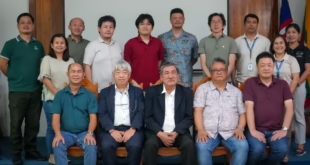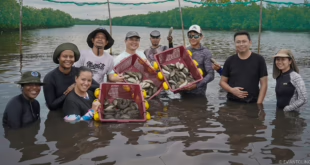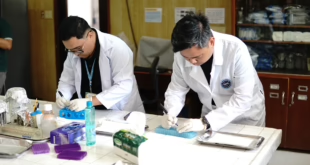Japan International Research Center for Agricultural Sciences (JIRCAS) has appointed a new researcher to be based in SEAFDEC/AQD starting from April 2019. Dr. Ryogen Nambu will succeed Dr. Masashi Kodama who worked in AQD since 2014 as a visiting scientist.
On 19 March, the two Japanese experts gave a back-to-back seminar held at the RD-AVR at the Tigbauan Main Station. Dr. Nambu presented his two case studies in Japan, focusing on the relationship between artificial fisheries and environment, while Dr. Kodama discussed the progress of his Integrated Multi-Trophic Aquaculture (IMTA) study in SEAFDEC/AQD.
Study on the relationships between artificial fisheries development and environment: Case studies in Japan
As a Senior Researcher at the National Research Institute of Fisheries Engineering (NRIFE), Japan Fisheries Research and Education Agency, Dr. Nambu introduced two case studies: (1) Evaluation of artificial reefs in increasing primary production in the Sea of Kashima; and (2) The mechanisms of Asari clam shellfisheries ground formation in Ise Bay, Central Japan.
“The objective of the first study is to verify the bottom-up effect of artificial reefs in relation to chemical factors such as nutrients, suspended solids, and organic matter,” Dr. Nambu presented.
Artificial reefs have an important role in increasing fish stock, improving the nursery grounds and enhancing production in an area. A study proved that artificial reef area has higher nutrients, thus, Dr. Nambu is expecting similar results for his study in Kashima Sea, East Japan.
“For the 2nd case study, the objective is to clarify the spatial-temporal distributions of the Manila clam and the surf clam in relation to the topographic features, sediment condition and wave motions on the flat.”
According to Dr. Nambu, both Manila clam and surf clam dominate tidal flats in Japan. While many previous studies focused on these two clams, ecological and spatial distribution aspects of their early life stage are not yet known. Hence, he determined the spatial distribution of these benthos organisms.
Nambu’s technical experience include population ecology, biochemistry, fisheries engineering, and biomineralization, among others. He was awarded his Ph.D. degree on the year 2006 under the Department of Life Science, Faculty of Bioresources, Mie University.
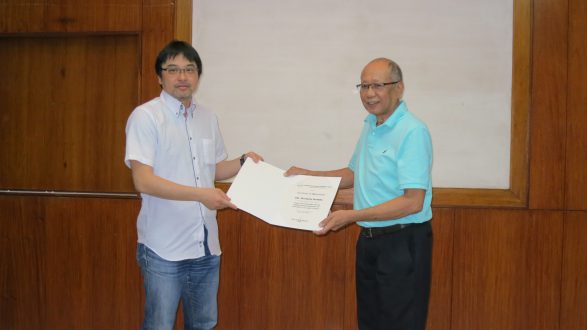
Overview and history of IMTA study, from ancient to modern and the recent decade in SEAFDEC/AQD
According to Dr. Kodama, modern IMTA started in the 1970s.The practice used to be called polyculture, integrated, or ecologically-engineered aquaculture until the term Integrated Multi-Trophic Aquaculture (IMTA) was defined in 2004.
“One of the objectives of IMTA is to mitigate impact by diversifying nutrient flow, and at the same time, diversifying yield and increasing income by secondary species,” Dr. Kodama stated.
On his first year, Kodama explored possible site location to conduct the on-farm experiment and decided to utilize the facility in Igang, Guimaras. They put up their IMTA design in Barangay Pandaraonan, near Igang Marine Station in the year 2015.
The IMTA candidate species used are milkfish, sandfish, and seaweeds. Their IMTA design was also modified according to the challenges faced in the field.
“This on-farm demonstration experiment is a collaboration with the local fisherfolk in Brgy. Pandaraonan, Guimaras. It’s like a community-based activity with a research institution and the LGU. And it was quite interesting to work with those local fisherfolk, I was able to experience their culture. That was a really good experience for me,” Dr. Kodama recounted.
“Since this is a community-based activity, we also experienced, possibly, poaching. That’s also a part of socioeconomic data, for me, indicating that that thing can happen. Also what is interesting, it happens after we have a good harvest, so they know that we have good milkfish in the pen, which means that our biological experiment is still successful. So that’s how I think what happened positively,” he added
The IMTA Project is a SEAFDEC/AQD – JIRCAS collaborative study that started in the year 2011. Phase 1 (2011- 2016) is titled ‘Development of Integrated Multi-Trophic Aquaculture Techniques for Livelihood Improvement,’ while Phase 2 (2016- 2012) is the ‘Demonstration and Verification of Sustainable and Efficient Aquaculture Techniques by Combination of Multiple Organisms.’
“I think we can divide this into three stages. First, there was Dr. Watanabe’s time, that was based on the laboratory, then we brought it out to the field, that’s phase two, that’s my time. We extract the actual problems, what are the possible practical solution in the field, and then summarize those problems and how to deal with it.’
“After this, we will proceed to more extension [activities] and explore possible location for an additional case study or the possible adopter; maybe the same IMTA design [can be adopted] in a certain location to create a map near our pilot study. That’s phase three and that will be the task for my successor, Dr. Nambu,” Dr. Kodama explained.
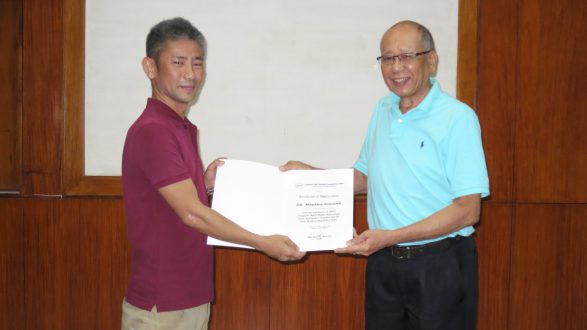
 SEAFDEC/AQD Southeast Asian Fisheries Development Center | Aquaculture Department
SEAFDEC/AQD Southeast Asian Fisheries Development Center | Aquaculture Department
